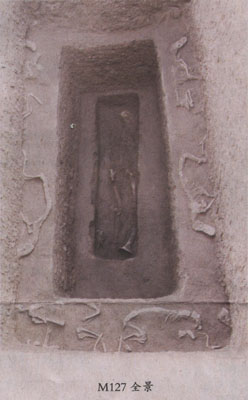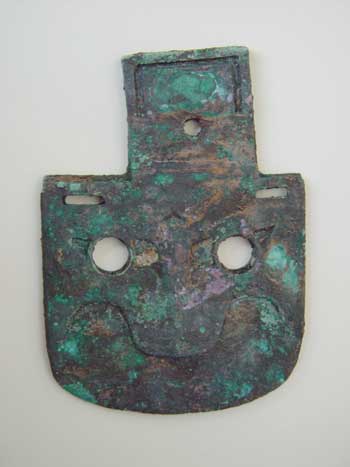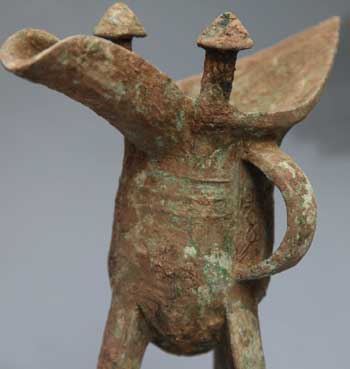The Daxinzhuang Site of Shang Dynasty in Jinan, Shandong Province
From March to July 2010 the Archaeological Department of the History and Culture College in Shandong University and Shandong Provincial Cultural Relics and Archaeological Institute had joinly conducted an excavation in the Daxinzhuang site in Licheng District of Jinan. An area of 900 square meters has been unclosed, which yielded a group of remains and cultural relics of Shang Dynasty, including a house foundation with a tamped wall, more than 200 ash pits, 1 well, 1 kiln site, over 40 tombs and more than 2000 objects of all kinds. Among the discoveries the most important ones are Shang Dynasty tombs containing bronze wares and the house foundation with a tamped wall, which is considered as a new important achievement after the discoveries of Shang Dynasty noble tombs and the oracle bones in 2003.

The Shang Dynasty tombs unclosed fall into two categories: Middle-sized tombs and small-sized tombs. The middle-sized tombs dating back to early Shang Dynasty is represented by Tomb M139, which is in the shape of a rectangular shaft pit with 3.22 m long, 2.24 m wide and remaining 1.57 m in depth. There is a course of earthen platform on the floor along the four sides, namely Ercengtai. On the eastern and western platforms there placed 3 skeletons of human sacrifices. In the middle of the floor there dug a small rectangular pit, namely waist pit (Yaokeng). The burial chamber consists of one inner and one outer coffin, which have been serious disturbed. The tomb contains 18 burial objects including 14 bronze wares, 1 chime stone, 2 jade wares and 2 pieces of round pottery shards with red paints. The bronze wares include 2 Ding tripot , 2 He vessels , 1 Jue tripot, 1 Jia tripot, 1 jar (You), 1 jar (Lei), 1 Dou vessel, 1 halberd (Yue), 1 pickaxe and 2 lances. All burial objects are placed on the platform (Ercengtai). According to their forms, decorations and combination feature, the tomb could be dated back to early Shang period, equivalent to late period upper Erligang culture.

The middle-sized tombs from late Shang Dynasty are very common in the Daxinzhuang site. The bronze ritual wares usually are Gu tripot and Jue goblet, weapons are dagger-axes, lances and halberd (Yue), and ceramics are Li vessel, Dou vessel, Gui vessel or Li vessel and Bu vessel. All tombs have an platform (Ercengtai) and a waist pit (Yaokeng). Dog sacrifice is prevalent, with distinct characteristics of the period and the region. Tomb M163 features a rectangular shaft pit with a small opening measuring 2.85 m long and 1.6 m wide, and a broad floor measuring 2.9 m long and 1.68 m wide. There is a course of platform (Ercengtai) on the floor. On its east and west sides there placed two sacrificed dogs respectively. The burial chambers consist of one inner and one outer coffin. The inner coffin, with cinnabar paved on the floor, contains a seriously-decaying skeleton. At the center of the floor there dug an oval-shaped waist pit (Yaokeng) which contains a dog skeleton. The burial objects include 6 bronze wares, 2 jade wares and 2 ceramics. Bronze wares are mainly weapons including 3 dagger-axes, 1 halberd (Yue), 1 dagger shaft end (Zun) and 1 sword; Jade wares include 1 halberd (Yue) and 1 Huang ornament; ceramics include 1 Li tripot and 1 Bu vessel. Bronze weapons are placed beside the head of the tomb occupant, or on the two sides of the waist. Jade dagger-axes are placed in the waist pit (Yaokeng). In the light of forms of the burial objects, this tomb could be dated back to the second period of the Yinxu ruins.

The small-sized tombs feature a smaller pit occasionally with a waist pit (Yaokeng). The burial objects, in the combinations of a single li tripot or a single basin, or a li tripot with a basin, a Gui vessel and a jar, are mainly placed on the south side of the head. The dog sacrifice could also be seen. For example, Tomb M161 has a pit measuring 1.48 m long and 0.5 m wide, buried with a sacrificed dog. On the floor there is an oval-shaped waist pit (Yaokeng). The burial objects include 1 Li tripot and 1 basin, both in a small size, 1 stone adze, and a clamshell on the right side of the skeleton.
Archaeologists also disclosed a large house foundation (F61) with a tamped wall, which is in rectangular shape and in the southeast-northwest direction, measuring 6.8 m wide and 13.6 m long, covering an area of 92.8 m². The house foundation is overlapped by tombs and ash pits belonging to the third period of the Yinxu ruins, therefore very possibly it is dated back to the second period, and contemporary to the Daxinzhuang inscribed oracle bones from the early Yinxu period. (Translator: Tong Tao)

